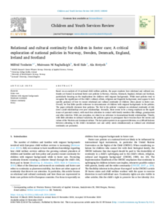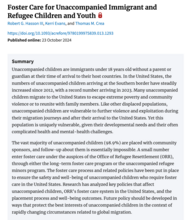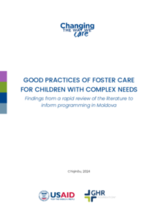Displaying 31 - 40 of 2214
Kin and fictive kin involvement can be protective following maltreatment and contribute to the development of children’s strengths. Findings show that support from kin may positively influence strength development for youth in foster care. Professionals in foster care should prioritize kin involvement to enhance support and develop youth strengths.
An analysis of 14 national foster care policies across six European countries found that while most acknowledge children’s cultural, ethnic, religious, and linguistic backgrounds, they provide little concrete guidance on ensuring relational and cultural continuity—particularly for children with migrant backgrounds. The study highlights four policy patterns, including prioritizing adult over peer relationships, emphasizing parental contact over extended family or transnational ties, assuming Western cultural norms, and struggling to balance immediate care needs with maintaining cultural and relational connections.
This research analyzed key policies that affect unaccompanied children, the Office of Refugee Resettlement (ORR)'s foster care system in the United States, and the placement process and well-being outcomes.
This report summarizes international best practices of specialized foster care and provides critical insights and recommendations for developing and scaling specialized foster care in Moldova.
Bune Practici de Asistență Parentală Profesionistă pentru Copiii cu Nevoi Complexe: Rezultatele analizei preliminare a literaturii de specialitate pentru pregătirea proiectului pilot privind asistența parentală profesionistă specializată în Republica Moldova rezumă cele mai bune practici internaționale în domeniul asistenței parentale profesioniste specializate, și oferă perspective și recomandări esențiale pentru dezvoltarea și extinderea asistenței parentale profesioniste specializate în Republica Moldova.
This study aimed to analyze the narratives of social educators regarding their practices within a foster care institution for children and adolescents in South Brazil.
This U.S.-based study aimed to get recommendations from stakeholders with lived and/or professional experience in foster care to understand how to increase participation in research and how to capture a broader representation of those impacted.
This qualitative study of cluster foster parents in Mpumalanga, South Africa, revealed that they are faced with extreme challenges such as lack of support, knowledge, and limitation of resources in fostering children with special needs.
This article explores the journey of foster care in India from 2010 to 2024 as an analysis and commentary on the substantive changes between the foster care 2016 model guidelines and the newly released foster care 2024 guidelines.
This article reviews a study conducted about child development in residential care, foster/kafalah care, and adoptive families. The authors of the study demonstrated that institutions cannot provide safe, stable, and shared care for children, and lead to substantial delays in their development, not only for physical health but also for mental health and neurocognitive growth.









